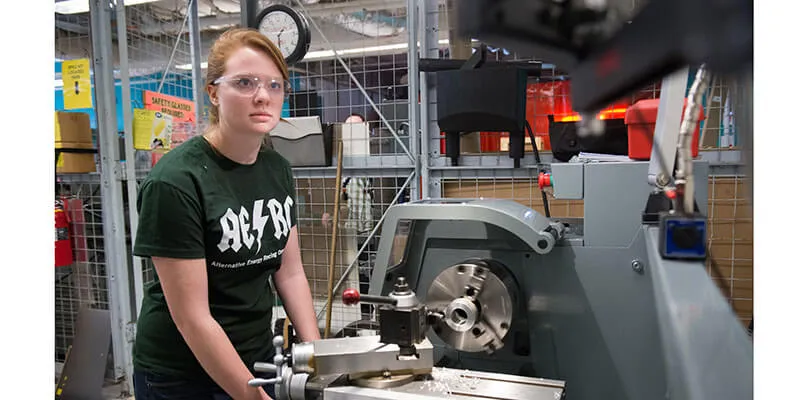Most students tinkering with their cars around the UVM campus are strapping down skis on Subarus, tossing laundry in Toyotas or scraping snow from an old Saab. But then there are the students who belong to the Alternative Energy Racing Organization (AERO), for whom working on wheels is serious business.
Since 2006, AERO has brought together Catamounts in a student-run club that designs and builds race cars not only for going fast, but also for slowing down climate change. These hybrid and electric vehicles (nicknamed Green Speed and Clean Speed) are giving UVM’ers hands-on experience, professional connections and a unique way to bond with fellow students, even if a few things break in the process.
“It was cool to learn so much in the field of alternative energy,” says Cullen Jemison, the most recent AERO president. “I could work my way through problems that I wouldn’t necessarily have learned how to solve yet, and I was also able to apply some of what I learned in UVM classes.”
Founded nearly 15 years ago, AERO has evolved with alternative energy trends, first focusing on hybrid cars before shifting toward electric vehicles. Its finish line every year: the Formula Hybrid competition hosted by Dartmouth at the New Hampshire Motor Speedway in the spring. Dartmouth’s Thayer School of Engineering created the event in 2006, with a conference that grew to 6 participants in 2007, and now 20 teams this past April.
UVM’s first appearance at Formula Hybrid was in 2008, when the AERO club won the Best Hybrid in Progress, the Chrysler Award for Best Hybrid System Engineering and the Thayer School of Engineering Dean’s Award for Innovation.
“In 2011, organizers started noticing that the industry wasn’t really going towards hybrid vehicles as much; they were focusing more on electric,” reports Jemison, adding that AERO followed Formula Hybrid’s lead in shifting gears toward electric cars. Having won third place in the electric-only category along with the Test Equity/Hit the Ground Running Award at last year’s competition, UVM returned to the New Hampshire Motor Speedway with high hopes for its low-to-the ground vehicle — despite some obstacles.
“We weren’t as prepared as we wanted to be; actually we had found some pretty major problems with the car,” admits Jemison. Somehow, the way the team mounted the motor was causing part of the structure to bend, and a chain to start skipping.
Two days before the competition, AERO struggled with last-minute solutions, finally deciding to decrease the amount of power to the motor by a half. The stress still carried through to the arrival at Formula Hybrid. “We really weren’t able to perform as well as the car could have, but even with that reduction in power, we were comparable with the other teams,” says Jemison. “And probably even more powerful than some of the cars that we’d made in the past at AERO.”
The team made it through the tech inspection, and then on to the track for the endurance event. “It was the most fun I’ve had driving any car,” says Jemison, “even if it was at half of its potential capability.”
AERO’s collaboration may have been part of the reason why Formula Hybrid judges decided to award UVM the first-ever Institute of Electrical and Electronics Engineers (IEEE) Excellence in Project Management Award. “With the combination of the graduating students and the up-and-coming members, I think we did a really good job with project management,” says Jemison, whose experience with AERO helped him land a job at Packetized Energy, founded by a fellow UVM alum. “So it was pretty nice to have that recognized by the competition.”
Where does the AERO club steer from here? Jemison sees another Formula Hybrid trip for 2020, while faculty advisor Dustin Rand says it will commit to all electric vehicles going forward. “This will hopefully match the trends of the commercial car industry and help the students gain valuable skills in this area,” he says. “They are working on developing a data acquisition system that will help them optimize future cars and drivers to better perform in their competitions.”
While the club has no set hours, and no pressure, members (up to 20 per year) are almost always found in AERO’s shop space, tinkering with designs, socializing, and learning the latest in the world of alternative energy.
“We always tell new members that they don’t need to put a huge amount of time, especially if you have other responsibilities,” says Jemison. “What you discover at AERO will be helpful when you leave UVM.”
